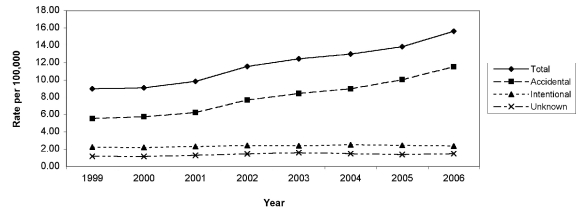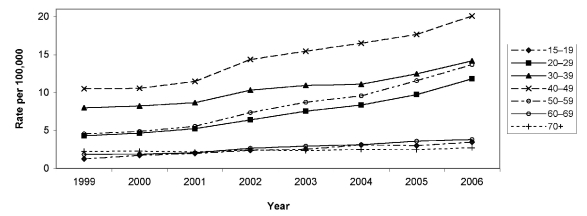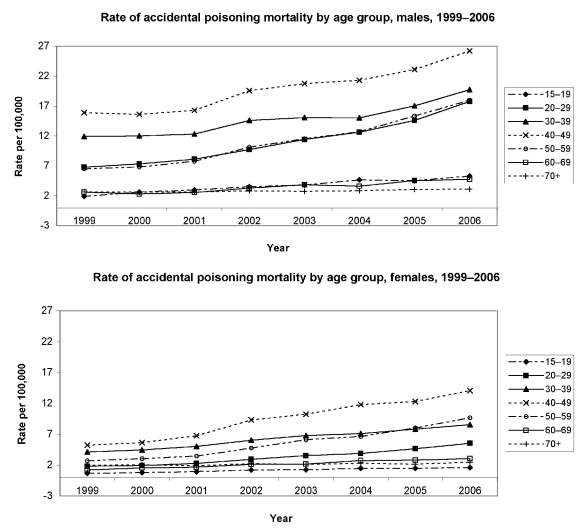SYNOPSIS
Objectives
Poisoning mortality rates have increased dramaticaly in the United States since the 1970s. This trend has been mainly attributed to an increase in accidental medication overdose deaths. The aim of this study was to analyze recent trends in poisoning mortality among U.S. adults using the most recently available data, and to examine gender and age as risk factors.
Methods
Data on injury-based mortality for the entire U.S. were obtained from the Web-based Injury Statistics Query and Reporting System (WISQARS™) for 1999–2006. We analyzed poisoning mortality rates by age group, gender, and intent. We modeled time trends in poisoning mortality using Poisson regression.
Results
Although intentional and undetermined poisoning mortality rates remained relatively stable, accidental poisoning mortality rates increased 108.5% between 1999 and 2006, and were significantly higher in each successive year (incidence rate ratio = 1.12 per year increase). Unintentional poisoning mortality rates were higher in men than in women; however, the increase in rate over time was higher in women than in men. The unintentional poisoning mortality rate was highest in individuals aged 40–49 years across all years studied, but we observed large increases in the rate for individuals aged 15–29 and 50–59 years during the study period.
Conclusions
Despite recently raised awareness, rates of unintentional poisoning mortality in the U.S. continued to rise in 2006. Men are at increased risk, but this disparity has decreased over time.
Mortality due to poisoning has increased dramatically in the United States since the 1970s. The most significant increase was reported in unintentional poisoning mortality rates, which more than tripled from 1990 to 2002.1 Whereas unintentional poisoning deaths were most often a consequence of illicit drugs in prior decades, since the latter half of the 1990s, medications began to account for a greater number of fatal poisonings.2 This is likely a reflection, in part, of the increasing prevalence of abuse of medications in the U.S.3 Awareness of the increasing rates of medication-related overdose has led to a recent pair of initiatives announced by the U.S. Food and Drug Administration and the Centers for Disease Control and Prevention (CDC), which are designed to reduce overdose mortality.4 Although available data from previous reports consistently indicated that rates of poisoning increased in the U.S.,1,2,5 it is possible that rates of overdose have started to level off as awareness of the problem has increased. Newer data are needed to determine if the trend in increased overdose has continued. Additionally, more research is needed to define specific age groups that are at elevated risk for overdose. Information on subgroups could help tailor future strategies to reduce overdose mortality.
The primary aim of this study was to analyze recent trends in poisoning mortality among U.S. adults using the most recently available data (2006). We focused on changes in the most recent years for which data were available (2004–2006). Additionally, we examined trends in accidental poisoning mortality among specific groups of U.S. adults defined by gender and age.
METHODS
We obtained data from the Web-based Injury Statistics Query and Reporting System (WISQARS™), which provides reports of injury-related data based on information from the National Vital Statistics System.6 WISQARS provides information on the annual mortality rates per 100,000 population for external causes of death from injury for specific race, gender, and age categories. Since 1999, causes of deaths have been coded by the National Center for Health Statistics (NCHS) using International Classification of Diseases, 10th Revision codes.
For this study, we examined mortality data for 1999–2006. We performed analyses using codes selected by CDC for each category of accidental and traumatic deaths. Accidental poisonings are those cases with the underlying cause of death coded as X40–X49. Intentional poisoning deaths are coded as X60–X69, and undetermined intent as Y10–Y19. To identify demographic subgroups of individuals at particularly high risk of poisoning, we examined accidental poisoning mortality rates by gender and age groups.
To assess time trends in mortality rates for poisoning, we estimated Poisson regression models with the outcome variable being the count of accidental poisoning deaths among those in the population at risk. There were two observations per year, with the separate observations for the count of accidental poisoning deaths among men and among women. Each model included years since 1999 as a predictor, coded such that 1999 = 0, 2000 = 1, and so on. We examined the association of gender with accidental poisoning mortality by including gender as a covariate, and tested if the change over time in poisoning mortality differed between men and women by including an interaction term for gender and time.
We performed all analyses for the adult and adolescent population (aged ≥15 years) using Stata® version 10.7 All analyses relied on de-identified, publicly available data. The University of Michigan Institutional Review Board approved this study.
RESULTS
Between 1999 and 2006, mortality rates for poisoning in the U.S. among individuals aged 15 years and older increased 74.1% (from 9.0 per 100,000 population in 1999 to 15.6 per 100,000 population in 2006) (Figure 1). Although intentional and undetermined poisoning mortality rates remained relatively stable, the accidental poisoning mortality rate increased 108.5% (from 5.5 per 100,000 population in 1999 to 11.5 per 100,000 population in 2006). This increase was greater between 2005 and 2006 (15.2%) than between 2004 and 2005 (11.5%) and between 2003 and 2004 (6.7%).
Figure 1.
Rates of poisoning mortality by intent among people aged >15 years, U.S., 1999–2006
Accidental poisoning mortality rates were higher in younger and middle-aged adults (aged 30–49 years) (Figure 2) than in adolescents (aged 15–19 years) or older adults (aged ≥60 years). We observed an increase in unintentional poisoning mortality rates in all age categories from 1999 to 2006, with the highest increase for individuals aged 50–59 years (200.4%) (Table). Between 2005 and 2006, the highest age-specific rate increase (21.4%) occurred in adults aged 20–29 years. This rate increase was higher than the increase between 2004 and 2005 for this same age group (16.5%). For middle-aged groups (those aged 30–60 years), increases were also substantial between 2004 and 2006. For those aged 50–59 years, we observed an 18.3% increase between 2005 and 2006 and a 20.8% increase between 2004 and 2005. The smallest change occurred in adults aged 70 years and older.
Figure 2.
Rates of accidental poisoning mortality by age group, U.S., 1999–2006
Table.
Changes in unintentional poisoning mortality rates in the United States, 1999–2006
Unintentional poisoning mortality rates from 1999 to 2006 for individuals aged 15 years and older were considerably higher in men than in women (11.4 per 100,000 population for men vs. 4.9 per 100,000 population for women). However, the increase in rates of accidental poisoning between 1999 and 2006 was higher for women than men in each age category, except for those aged 15–19 years (Table). For men, the highest unintentional poisoning mortality rate in 2006 for a particular age group was for those aged 40–49 years (26.2 per 100,000 men), a 13.4% increase from 2005. Similarly, in women, the highest unintentional poisoning mortality rate for a particular age group in 2006 was for those aged 40–49 years (14.1 per 100,000 women), a 14.2% increase from 2005.
Poisson regression modeling indicated that the number of accidental poisoning deaths increased significantly (p<0.001) and by a factor of 1.12 each year (95% confidence interval [CI] 1.11, 1.12). While women had a lower rate of poisoning mortality (p<0.001), a Poisson model including time, gender, and an interaction of time and gender confirmed that the increase in rate over time was significantly greater (p<0.001) for women than men, with a β=−1.00 (95% CI −1.02, −0.97) for women compared with men in 1999 and a β=0.04 (95% CI 0.03, 0.04) for the interaction of years since 1999 and gender.
Figure 3 presents gender-stratified changes in rate of accidental overdose mortality by age group. The rate of overdose was highest for those in the 40–49 age group from 1999 to 2006 for both men and women. Those in the 30–39 age group had the second-highest rate for most of the 1999–2006 time period for both men and women; however, women aged 50–59 years had a higher rate of poisoning mortality than women aged 30–39 years for the first time in 2006.
Figure 3.
Rates of accidental poisoning mortality by age group and gender, U.S., 1999–2006
DISCUSSION
Accidental poisoning mortality rates increased 108.5% in the seven years between 1999 and 2006. Our findings indicated that the trend reported in previous research1,2,5,8,9 is specific to unintentional poisonings and has continued in recent years, despite a growing awareness of the problem of unintentional poisoning. Additionally, an increase in unintentional poisoning mortality continued and intensified in the most recent years examined (2005–2006).
Although unintentional poisoning mortality rates were higher in men than in women across all age groups, the increase in rate of unintentional poisoning between 1999 and 2006 was higher in women than in men. In both genders, consistent with research on prior years of data,1 rates were highest in individuals aged 41–50 years in 2006. Significant increases in unintentional poisoning mortality were observed for individuals aged 50–59 years, particularly among women. Older adults may represent an increasingly important risk group for poisoning mortality.
These findings confirmed that mortality attributed to poisoning poses a significant threat to population health in the U.S. The increase in poisoning mortality rates is attributed mainly to an increase in accidental poisoning deaths. Prior research indicates that an increasingly greater proportion of these deaths is likely caused by abuse or diversion of prescribed drugs.5,10 We observed large increases in unintentional poisoning mortality for individuals aged 15–29 years, and this finding is alarming given recent research indicating that nonmedical prescription drug use has recently increased among teenagers and young adults, while their use of marijuana has decreased.11
Among prescription drugs, there has been a dramatic increase in accidental poisonings due to opiate pain medications in particular;1,2 a similar increase has not been observed for cocaine or heroin.1 While trends in poisoning due to specific substances was outside the scope of this study, it is likely that the increases in the most recent years have continued to be a result of increasing numbers of opiate pain medication poisonings. The persistent increases in opiate pain medication overdoses pose a significant challenge for treatment providers, who must balance the need to effectively manage pain—which worldwide is often undertreated12,13—with overdose risk.
The growing role of opiate analgesics in accidental poisoning mortality has implications for health policy. The increase in accidental opiate pain medication poisonings between 1999 and 2002 paralleled U.S. national increases in volume sold of these medications,1 and states with higher volumes of opiate medications sold also had higher rates of fatal poisonings by any drug in 2002.14 Consequently, reducing opiate pain medication diversion and implementing policies to ensure safe and reasonable prescribing practices of these medications are important steps toward the goal of reducing poisoning mortality.
Limitations
These results should be interpreted with caution for several reasons. The accuracy of the findings depends on the accurate categorization of overdose as a cause of death on death records. Similarly, it is possible that growing awareness of overdose as a public health problem may increase the likelihood that deaths are categorized as overdoses. Additionally, the available data from CDC do not allow for determination of the extent to which the overdose was due to specific substances. More broadly, the observational nature of these analyses does not allow for the determination of what specifically caused the increased rates of overdose, or why the increase may be greater in some groups compared with others.
CONCLUSIONS
These data indicate that the national trend of increased rates of overdose is continuing, and the rate of increase has accelerated in recent years. Overdose mortality is disproportionately affecting middle-aged and young adults. The rate of accidental poisoning is greater for men than women, but the increase over time has been greater for women than men. Future prevention efforts, including education efforts about the potential risk of overdose associated with both licit and illicit drug use, should target specific high-risk groups.
REFERENCES
- 1.Paulozzi LJ, Budnitz DS, Xi Y. Increasing deaths from opioid analgesics in the United States. Pharmacoepidemiol Drug Saf. 2006;15:618–27. doi: 10.1002/pds.1276. [DOI] [PubMed] [Google Scholar]
- 2.Paulozzi LJ, Xi Y. Recent changes in drug poisoning mortality in the United States by urban-rural status and by drug type. Pharmacoepidemiol Drug Saf. 2008;17:997–1005. doi: 10.1002/pds.1626. [DOI] [PubMed] [Google Scholar]
- 3.Compton WM, Volkow ND. Major increases in opioid analgesic abuse in the United States: concerns and strategies. Drug Alcohol Depend. 2006;81:103–7. doi: 10.1016/j.drugalcdep.2005.05.009. [DOI] [PubMed] [Google Scholar]
- 4.Kuehn BM. Efforts aim to curb opioid deaths, injuries. JAMA. 2009;301:1213–5. doi: 10.1001/jama.2009.367. [DOI] [PubMed] [Google Scholar]
- 5.Hall AJ, Logan JE, Toblin RL, Kaplan JA, Kraner JC, Bixler D, et al. Patterns of abuse among unintentional pharmaceutical overdose fatalities. JAMA. 2008;300:2613–20. doi: 10.1001/jama.2008.802. [DOI] [PubMed] [Google Scholar]
- 6.Centers for Disease Control and Prevention (US), National Center for Injury Prevention and Control. WISQARS™ (Web-based Injury Statistics Query and Reporting System) [cited 2009 May 29]. Available from: URL: http://www.cdc.gov/ncipc/wisqars.
- 7.StataCorp. College Station (TX): StataCorp; 2008. Stata®: Version 10.0. [Google Scholar]
- 8.Hu G, Baker SP. Trends in unintentional injury deaths, U.S., 1999–2005: age, gender, and racial/ethnic differences. Am J Prev Med. 2009;37:188–94. doi: 10.1016/j.amepre.2009.04.023. [DOI] [PubMed] [Google Scholar]
- 9.Warner M, Chen LH, Makuc DM. NCHS Data Brief. Hyattsville (MD): National Center for Health Statistics (US); 2009. Increase in fatal poisonings involving opioid analgesics in the United States, 1999–2006; pp. 1–8. 2009. [PubMed] [Google Scholar]
- 10.Unintentional and undetermined poisoning deaths, 11 states, 1990–2001. MMWR Morb Mortal Wkly Rep. 2004;53(11):233–8. [PubMed] [Google Scholar]
- 11.Substance Abuse and Mental Health Services Administration (US) Results from the 2006 National Survey on Drug Use and Health: national findings. Rockville (MD): Department of Health and Human Services, Office of Applied Studies (US); 2007. NSDUH Series H-32, DHHS Publication No. SMA 07-4293. [Google Scholar]
- 12.World Health Organization. Access to controlled medications programme. WHO Briefing Note. 2007. Mar, [cited 2009 May 4]. Available from: URL: http://www.who.int/medicines/areas/quality_safety/access_to_controlled_medications_brnote_english.pdf.
- 13.World Health Organization. Impact of impaired access to controlled medications. 2009. [cited 2009 May 7]. Available from: URL: http://www.who.int/medicines/areas/quality_safety/Impaired_Access/en.
- 14.Paulozzi LJ, Ryan GW. Opioid analgesics and rates of fatal drug poisoning in the United States. Am J Prev Med. 2006;31:506–11. doi: 10.1016/j.amepre.2006.08.017. [DOI] [PubMed] [Google Scholar]






